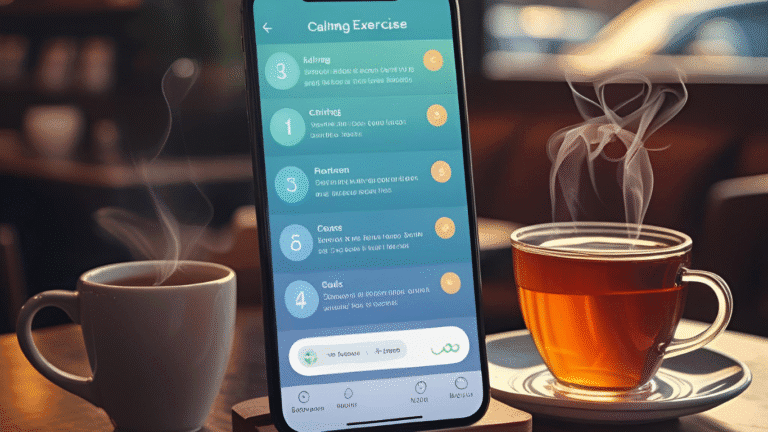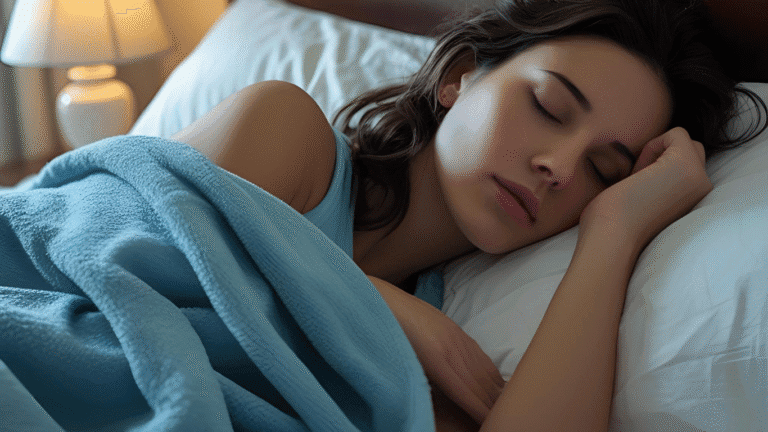How to Sleep Fast and Conquer Insomnia for Good
How to sleep fast is one of the most searched health queries in the U.S.—and for good reason. Insomnia now affects nearly one in three adults, turning bedtime into a nightly struggle instead of a time for rest and recovery.
As sleeplessness rises, so does the use of over-the-counter sleep aids, melatonin supplements, and even prescription medications. But these solutions often offer only temporary relief—and can sometimes worsen the issue. Studies increasingly show strong links between chronic sleep deprivation and mental health conditions like anxiety and depression.
The good news? You don’t need quick-fix gimmicks to reclaim restful nights. With evidence-based strategies grounded in neuroscience and behavioral sleep medicine, it’s entirely possible to retrain your brain and body to fall asleep naturally, consistently, and quickly.
What Really Happens When You Can’t Sleep
Everyone experiences a sleepless night occasionally—but when difficulty falling or staying asleep becomes frequent, it may signal chronic insomnia. Understanding the biological and emotional mechanisms behind this condition is key to learning how to sleep fast and protect long-term health.
Unlike occasional sleeplessness triggered by a stressful event or a late night out, chronic insomnia is often rooted in physiological dysregulation. Elevated cortisol levels, often caused by prolonged stress or anxiety, keep the brain in a heightened state of alertness, delaying sleep onset. At the same time, irregular light exposure and inconsistent sleep schedules can suppress melatonin production, the hormone that tells your body it’s time to rest.
Sleep also follows a natural circadian rhythm—a 24-hour internal clock that governs when we feel alert or drowsy. Disruption to this rhythm, such as staying up late with screens or working irregular shifts, confuses the body’s sleep signals, making fast sleep initiation difficult.
The toll of chronic insomnia extends beyond fatigue. Emotional side effects include increased irritability, mood swings, and anxiety. Cognitive impacts are just as serious, with reduced concentration, memory lapses, and decision fatigue becoming daily struggles.
Common Causes of Insomnia and Their Prevalence (%)
| Cause | Prevalence (%) |
|---|---|
| Stress / Anxiety | 48% |
| Caffeine / Alcohol | 32% |
| Poor Sleep Environment | 27% |
| Medical Conditions | 23% |
🔗 Evidence-Based Sources CDC – Sleep Disorders and Sleep Hygiene
Myth-Busting: Popular Sleep Hacks That Don’t Work
In the effort to discover how to sleep fast, many people turn to common advice that lacks scientific validation. These popular sleep hacks may sound helpful but can be misleading or even counterproductive.
“Drink warm milk before bed”
This classic suggestion stems from the belief that milk contains tryptophan, an amino acid involved in the production of serotonin and melatonin—two hormones that regulate sleep. While it is true that tryptophan plays a role in promoting drowsiness, the concentration of this compound in a single glass of milk is biologically insignificant in isolation. To meaningfully influence sleep physiology, tryptophan must be consumed in much higher doses and accompanied by specific carbohydrates to cross the blood-brain barrier effectively.
Moreover, the process of drinking warm milk may be comforting not because of its chemical properties, but due to psychological conditioning. For many people, the ritual of a warm bedtime drink can signal to the brain that it’s time to unwind. This association—built through repetition—may promote relaxation, but it does not equate to a reliable or measurable improvement in sleep onset or quality. In clinical sleep medicine, milk is not considered an evidence-based treatment for insomnia.
“Use sleep sounds or calming music”
While ambient sounds, such as white noise, rainfall, or soft music, are often marketed as sleep aids, their effectiveness remains inconsistent across individuals. These auditory stimuli may help some people mask disruptive background noise or reduce feelings of loneliness at bedtime, potentially aiding relaxation. However, controlled studies have shown mixed results regarding their impact on actual sleep onset latency and overall sleep quality.
For others, especially those with heightened auditory sensitivity or underlying anxiety, constant background noise can become mentally stimulating rather than calming. The brain may remain partially alert in response to even soft, repetitive sounds—particularly if the audio includes patterns, changes in pitch, or emotional associations. Additionally, relying on external audio to fall asleep may lead to conditioned dependence, where individuals struggle to sleep without it, ultimately interfering with the development of natural sleep regulation.
As a result, sound-based sleep tools are not recognized as primary treatments for insomnia in clinical sleep guidelines. They may offer short-term comfort for some, but they do not address the behavioral or neurological causes of chronic sleep difficulty.
“Stay in bed until you fall asleep”
This commonly shared advice can be counterproductive—especially for those experiencing chronic insomnia. When individuals lie in bed awake for extended periods, the brain begins to associate the bed not with sleep, but with wakefulness, frustration, and hyperarousal. Over time, this weakens the natural cue that the bed is a place for rest, contributing to a cycle of conditioned insomnia.
Behavioral sleep experts strongly discourage staying in bed when sleep does not come within approximately 20 minutes. Instead, stimulus control therapy, a cornerstone of cognitive behavioral treatment for insomnia (CBT-I), advises leaving the bed and engaging in a quiet, non-stimulating activity (such as reading under low light or listening to calm instrumental music). Once drowsiness returns, the person should go back to bed.
This technique is designed to reestablish a strong mental and physiological link between the bed and sleep—not wakefulness or stress. It helps retrain the brain to associate lying in bed with quick sleep onset rather than anxiety, tossing and turning, or clock-watching. Over time, this shift supports faster, more consistent sleep initiation without reliance on external aids.
“Melatonin cures everything”
Melatonin is one of the most commonly used over-the-counter supplements for sleep, but its effectiveness is often misunderstood. It is a naturally occurring hormone produced by the pineal gland in response to darkness. It plays a key role in regulating the body’s circadian rhythm, signaling that it’s time to prepare for sleep. However, taking melatonin supplements does not guarantee faster or better sleep for everyone.
Research supports the short-term use of melatonin primarily for circadian-related issues, such as jet lag, shift work, or delayed sleep-wake phase disorder. In these contexts, melatonin can help realign the body’s internal clock. But when used as a general solution for chronic insomnia, its effectiveness is limited. Clinical trials have shown inconsistent results regarding improvements in sleep onset, quality, or duration for individuals without circadian misalignment.
Moreover, melatonin supplements are often taken incorrectly. Timing is critical—taking it too early or too late can shift the body clock in the wrong direction, leading to daytime drowsiness or further disruption of natural sleep rhythms. Dosage is also a concern: many commercial melatonin products contain much higher levels than the body needs, and lack of regulation can result in inconsistent potency.
In behavioral sleep medicine, melatonin is not considered a first-line treatment for insomnia. It may offer situational relief when used appropriately, but it should not replace comprehensive, evidence-based strategies for improving sleep.
Quick fixes often fail because they don’t address the true causes of insomnia. Learning how to sleep fast requires a shift toward science-backed methods that correct behavior and biology—not temporary tricks.
How to Sleep Fast Using Proven Medical Strategies
Learning how to sleep fast isn’t about hacks—it’s about evidence. Behavioral sleep medicine provides effective tools that address the root of insomnia, not just the symptoms. The gold standard? Cognitive Behavioral Therapy for Insomnia (CBT-I).
CBT-I: Retraining Your Sleep Brain
CBT-I is a structured, short-term therapy that targets unhelpful sleep thoughts and behaviors. It helps rewire the brain’s association with sleep using proven psychological techniques. Unlike medications, CBT-I treats the underlying causes—such as sleep anxiety and inconsistent habits—without side effects.
Major sleep organizations, including the American Academy of Sleep Medicine, recommend CBT-I as the first-line treatment for chronic insomnia. Results often appear within weeks and are long-lasting.
Sleep Restriction Therapy
This strategy seems counterintuitive: limit your time in bed to only the hours you actually sleep. At first, this leads to mild sleep deprivation—but it builds strong sleep pressure. Over time, your body learns to fall asleep faster and stay asleep longer.
Once sleep becomes consistent, your time in bed is gradually increased. This method recalibrates your circadian system and restores sleep efficiency. Studies show it’s especially effective when paired with CBT-I.
Stimulus Control: Break the Bed-Wake Connection
People with insomnia often stay in bed hoping to drift off. But this reinforces wakefulness in bed. Stimulus control reverses this. If you’re awake for more than 20 minutes, get up. Do something quiet in low light—then return only when sleepy.
The goal is to make your bed a cue for sleep, not frustration. This simple habit reshapes your brain’s associations and supports natural sleep onset.
Mind-Body Relaxation: Science-Backed Calm
Relaxation techniques signal the nervous system to downshift. This is especially helpful before bed or if you wake at night. Two methods with clinical support:
- Progressive Muscle Relaxation (PMR): Tense and release each muscle group from feet to head. This reduces physical tension and anxiety.
- Diaphragmatic Breathing (4-7-8): Inhale for 4 seconds, hold for 7, exhale for 8. This slows the heart rate and reduces cortisol.
These strategies are not gimmicks—they’re neurologically grounded tools to help you fall asleep faster and sleep more soundly.
🔗 American Academy of Sleep Medicine: CBT-I
Redesigning Your Sleep Environment
Room Temperature Matters
The ideal room temperature for sleep is between 60–67°F. As you fall asleep, your core body temperature naturally drops. A cooler room supports this physiological change, sending signals to your brain that it’s time to rest. Temperatures above or below this range can interfere with this process—too warm, and your body struggles to cool down; too cold, and your body expends energy trying to stay warm. Maintaining this thermal “sweet spot” can improve sleep efficiency, reduce wake-ups, and promote longer stretches of restorative deep sleep.
Total Darkness Signals Sleep
Even small amounts of light—like from streetlights, nightlights, or glowing screens—can suppress melatonin, the hormone that signals your body it’s time to sleep. This disruption delays sleep onset and reduces sleep quality. To combat this, use blackout curtains to eliminate outside light and switch off electronic devices at least 30 minutes before bed. Blue light from phones, tablets, and TVs is especially disruptive. A consistently dark environment helps your brain maintain a healthy circadian rhythm, leading to deeper and more consistent rest.
Noise Control
Silence isn’t always the best backdrop for sleep. Many people fall asleep faster with a steady, low-level sound like white or pink noise, which masks jarring disturbances. These sounds create a consistent auditory environment that can reduce the brain’s reactivity to sudden noises. However, unpredictable or intermittent sounds—like honking, barking, or slamming doors—can fragment sleep and prevent deeper stages of rest. Experimenting with different soundscapes helps you find what supports your sleep best.
Bedding and Pillow Positioning
Supportive bedding plays a crucial role in how quickly and deeply you sleep. A mattress that matches your sleep position—firm for back sleepers, softer for side sleepers—helps maintain spinal alignment. Pillows should keep your neck in a neutral position; too high or too flat can cause tension and restlessness. Poor support leads to frequent awakenings, stiffness, and disrupted sleep cycles. Investing in the right bedding reduces pressure points and helps your body fully relax into restorative rest.
How to Sleep Fast with Lifestyle Shifts That Stick
Limit caffeine after 2 PM
Caffeine has a half-life of about 5–6 hours, meaning half the amount you consume stays active in your system for that long. For example, a cup of coffee at 3 PM could still affect your body well into the evening. Even small amounts—like those in tea, chocolate, or soda—can delay melatonin release and disrupt sleep onset. Avoiding caffeinated drinks after 2 PM helps your body transition more smoothly into its natural wind-down phase, promoting faster and deeper sleep.
Move dinner earlier
Late-night eating can disrupt both your digestive system and your sleep cycle. When you eat close to bedtime, your body stays active processing food instead of preparing for rest. This can delay melatonin production—the hormone that signals sleep readiness. Heartburn or discomfort may also arise, especially from heavy or spicy meals. To support healthy sleep onset, aim to finish dinner 2–3 hours before bed. This gives your body time to shift from digestion to relaxation, making it easier to fall asleep quickly and sleep more soundly.
Daily movement (not vigorous at night)
Exercise is a proven sleep enhancer. It helps regulate your internal body clock and reduces stress hormones like cortisol. However, timing matters. While morning and afternoon workouts support a natural sleep-wake rhythm, vigorous evening sessions can raise heart rate and adrenaline—making it harder to wind down. If nighttime is your only option, stick to calming movement like stretching, walking, or gentle yoga. These can relax your muscles and quiet your mind without disrupting your ability to fall asleep.
Digital detox before bed
Blue light exposure in the evening delays melatonin release, making it harder to fall asleep. To protect your natural sleep-wake cycle, unplug from screens at least 30–60 minutes before bed. Instead, create a calming wind-down routine—read a physical book under a soft lamp, journal your thoughts, or do light stretches. These low-stimulation habits signal your brain that it’s time to rest, helping you fall asleep faster and more peacefully.
Daily Habits That Affect Sleep Onset Time
| Habit | Impact on Sleep |
|---|---|
| 30+ mins of daylight | Improves onset |
| Blue light at 10 PM | Delays onset |
| Caffeine after 3 PM | Delays sleep |
| Evening alcohol | Fragmented sleep |
These habits can either support or sabotage your ability to fall asleep quickly. Aim to get daylight exposure early, limit stimulants and screens in the evening, and avoid alcohol close to bedtime for better sleep onset.
When You Still Can’t Sleep: Know When to Get Help
If you’ve optimized your sleep environment, followed proven techniques, and still struggle to fall asleep most nights, it may be time to seek professional help.
When to See a Sleep Specialist
- Difficulty falling or staying asleep at least 3 nights per week
- Ongoing sleep issues lasting more than 3 months
- Daytime fatigue, irritability, or impaired focus despite adequate time in bed
- Reliance on sleep aids without consistent improvement
Sleep specialists can conduct evaluations like overnight polysomnography or at-home sleep studies to diagnose underlying conditions.
Common Medical Causes of Chronic Sleep Issues
🫁 Sleep Apnea
Characterized by loud snoring, choking during sleep, or waking gasping for air. It disrupts breathing and reduces oxygen, severely affecting rest quality.
🦵 Restless Legs Syndrome (RLS)
Marked by an irresistible urge to move the legs, especially at night. Often described as crawling or tingling sensations that worsen at rest and improve with movement.
🔁 Circadian Rhythm Disorders
People with delayed sleep phase disorder or shift work sleep disorder may find their internal clock out of sync with conventional sleep times.
If any of these symptoms sound familiar, don’t wait—professional guidance can lead to accurate diagnosis and tailored treatment, helping you finally sleep fast and well.
Conclusion
The key to learning how to sleep fast isn’t in gimmicks or quick-fix solutions—it’s in rewiring your habits with science-backed strategies. From aligning your environment to reshaping your evening routine, small changes can lead to big improvements.
Consistency matters more than perfection. Your body responds best to regular cues: dim light, a cool room, and a wind-down ritual it can count on. One night of great sleep doesn’t fix weeks of poor rest—but a steady pattern can.
Explore what works for you. Use evidence-based tips, track your progress, and adjust gradually. In the end, sleeping fast isn’t a trick—it’s a skill you build through intentional daily choices.
FAQ: How to Sleep Fast – Your Questions Answered
Disclaimer
The information in this blog is for general educational purposes only and is not a substitute for professional medical advice, diagnosis, or treatment. Always consult your physician or a qualified healthcare provider before making changes to your sleep habits, especially if you experience ongoing sleep difficulties, insomnia, or symptoms such as snoring, daytime fatigue, or restless legs. Never disregard medical advice or delay seeking care based on something you read here.
What’s your go-to wind-down habit?
Drop a comment below and share what helps you fall asleep faster.

Alexia Greene is a health blogger dedicated to making wellness simple, practical, and accessible for everyone. With a strong background in nutrition and healthy living, she writes about balanced diets, fitness tips, and mindful habits that support long-term well-being. Alexia’s mission is to empower readers with trustworthy information and actionable steps they can use in their everyday lives.
When she’s not writing, Alexia enjoys cooking wholesome meals, practicing yoga, and exploring new ways to live a healthier lifestyle. Her approachable style and evidence-based advice make her a trusted voice in the world of health and wellness blogging.


